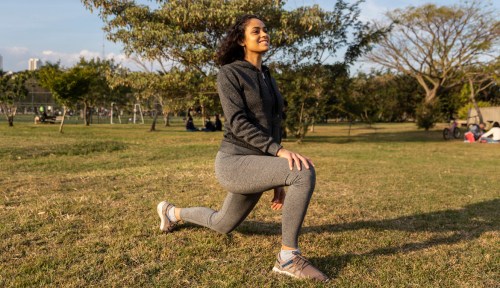Our editors independently select these products. Making a purchase through our links may earn Well+Good a commission
I spend my work day sitting in front of a computer, so I’ve pretty much assumed that my hip mobility is less than stellar. In fact, many people these days are dealing with tight hips, too—in particular, tightness in the hip flexor is extremely common. And it’s not always a mark of a stationary lifestyle (though that can definitely be a contributing factor); even athletes get tight hips.
Experts in This Article
It’s also not always clear if you need to work on mobility or strengthening your hips. But there are a couple of super simple tests you can do to see if you need a little TLC for your hip joint range of motion. For me, the results were revealing, and even a bit surprising.
What is hip mobility—and why does it matter?
First things first: Hip mobility is your hip joint’s ability to move through its full range of motion, meaning your leg can extend both in front of and behind you. This is important because a lack of mobility in your hip joint can cause your hip flexors to shorten, which can cause lower back pain and impact your posture. It warrants even more concern for runners, because stunted hip mobility can undermine your running form by not allowing your leg to stretch far enough back behind you when you run.
“When you run, you want half your energy to come from muscles working and half of it to come from storing and releasing energy in your tendons,”says Jay Dicharry, MPT, a physical therapist, running coach, and author of the recent book Running Rewired. Your legs should be like a pendulum, swinging back and forth in front of and behind you.
Your legs should be like a pendulum, swinging back and forth in front of and behind you.
“If you don’t have good hip mobility, the problem is that the pendulum, instead of swinging equally front and equal back, tends to swing out in front of you and then just kind of under you, so it doesn’t get a chance to swing back behind you. You actually lose out on the ability to apply that plasticity that you stored in your tendons as you run.”
So running without full hip mobility causes you to rely on your muscles more than the explosive release of your tendons, which can be even more exhausting. Plus, if you become aware that your stride is not swinging far back enough, but you still lack hip mobility, you may try to compensate by swaying your lower back, and that can cause pain. Any way you slice it, “you’re making running harder just by not having the range of motion,” Dicharry says.
90/90 hip switch test
The first 30-second test that physical therapists use is a move called the 90/90 Hip Switch. Physical therapist Ashley Taylor, DPT, in La Jolla, California, says, “This can be a great self-assessment tool.” And it’s one that also ends up being educational—you learn more about your body in the process—because “you are testing hip movement in all planes, bilaterally.” In layman’s terms, you’re testing both sides, in all directions of movement.
- 1.Sit on the floor with both of your knees bent to 90 degrees—one leg in front and one to the side.
- 2.Without using your hands, rotate to the other side while keeping your butt and heels on the floor.
- 3.Once you’ve flipped sides, go back in the other direction.
What your 90/90 results can tell you
Could you do it without lifting your booty or your heels? If not, you may have tight iliopsoas muscles, also known as the hip flexors. “The iliopsoas muscle is a strong hip flexor and becomes even tighter with prolonged sitting (like at work or a long drive),” she says. “This is very important to be mindful of.”
If you find you can’t quite make it to the other side without lifting your heels or booty, it’s time to get into some hip openers. “If you have tight hips, it’s crucial to stretch and train the hips in all planes,” says Taylor. “I like to use yoga!”
Also, if you can see a physical therapist in person (or even on a video consult) and do this test in front of them, that’s even better, she says. A practitioner will be able to assess your hips and determine if the issue is coming from the joint or tight muscles.
The doorway hip mobility test
Dicharry like to use this hip mobility test, which he includes in his book Running Rewired (along with other running form tests), that can clue you in on whether mobility is something you need to work on.
Essentially, it works by testing whether there is tightness in your hip flexor. If there’s tightness, it indicates that your hip doesn’t move around very much, which in turn causes your hip flexor to be in a shortened position—which then makes it harder for you to stretch your leg back. It’s a vicious cycle!
To see what’s going on, all you need is a doorway and potentially a towel or mat to rest your knee on.
- 1.Come into a kneeling position in a door jam, with your mid/upper back against the doorway. Your upper shins should be on the floor extending on either side of the doorway.
- 2.Come into a half kneeling pose: Keep one knee bent on the floor, but place the foot of the other leg on the floor in front of you so there is a 90 degree angle at your hips between your torso and quads, and a 90 degree angle at your knee between your upper and lower legs. Make sure your upper/mid back is still in contact with the doorway, and that there is space between your lower back and the doorway.
- 3.Tilt your pelvis forward so that the space between the wall and your lower back disappears.
- 4.Observe how the front of the leg of your leg with the knee on the floor feels. Do you feel:
Here’s Dicharry demonstrating how to do the test:
Decoding the results of your doorway hip mobility test
When I first did the test, I couldn’t tell whether I was getting option 1 or 2. On my left side, I felt some pulling, but was that really the telltale sign I was looking for? Then, I tried the other side, and YOW. It was clear my hip mobility on my right side was struggling… but, conversely, that I was doing okay on my left! This imbalance makes sense: I’ve had injuries to my hamstring and ankle on my right side, while my left side has been injury free. No wonder things were a little off for one side and not the other.
So all that is to say, if you’re having trouble figuring out whether you’re getting option 1 or 2, option 2 is really a “you’ll know it when you feel it” sensation. At the same time, mobility is not necessarily black or white—it’s possible things could be a little tight, but not to the level of my struggling right side.
“Make sure to assess how you feel on one side so you can compare it to the opposite side,” says Taylor (which applies to both tests). “Take mental notes so you can be more in tune with your body.”
If you get option 1, your hip flexor muscle doesn’t seem to be tight, so doing dynamic stretching before runs or other activities is sufficient to keep mobility in those hip joints. Dicharry notes that it’s still important to work on strength and control around the joint to maintain hip mobility, so keep dynamic stretches like leg swings or body strength exercises like one leg standing poses in your lineup.
If you get option 2, don’t despair, but it’s a sign that your hip mobility could use some work.
How to open up those hips
1. Kneeling hip flexor stretch
Dicharry recommends doing a kneeling hip flexor stretch for three minutes per day.
- 1.Kneel on a pad or pillow, making sure to keep the thigh of the leg you are kneeling on vertical.
- 2.Tuck your pelvis under. Hold this position for 3 minutes.
- 3.To increase the stretch, position the foot of your kneeling leg out to the side a few inches (this will rotate your thigh inward) before moving into a posterior pelvic tilt.
2. Supine twists
Try supine twists (thank you, yoga!) for the piriformis and glute muscles. Relief of tightness in these areas can also help your hips to release.
3. Stretch your inner thighs
When your hips are week, you inner thighs (adductors) tend to overcompensate. Give that some area some relief by trying these inner thigh stretches.
4. Stretch your hamstrings
Do stretches for the hamstrings (because tight hamstrings also contribute to hip stiffness and pain).
If you really want to give your hips some love, don’t stop there, says Taylor. “I would take additional steps by attending a beginners yoga class, as you will complete movements on both sides, as well as begin to get in tune with yourself and your body,” she says. And adding in a regular mobility workout to your routine can offer surprisingly effective results. You can also check out more hip mobility exercises here.
Personally, I’m going to work on mobility for my right side so I can even things out a little bit, because muscle imbalances can lead to discomfort, uneven muscle development, and injury. Dicharry says with just three minutes of daily stretching, you should see results in about 10 weeks. And if that sounds like a lot, keep the faith.
“Your body can and will adapt,” Dicharry says.
Sign Up for Our Daily Newsletter
Get all the latest in wellness, trends, food, fitness, beauty, and more delivered right to your inbox.
Got it, you've been added to our email list.











